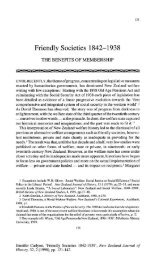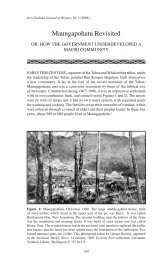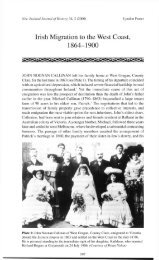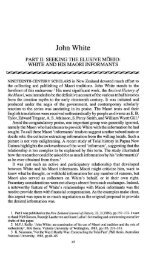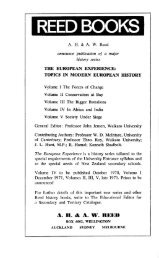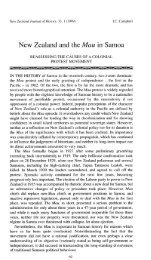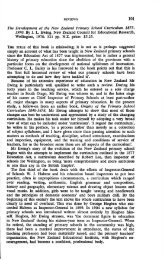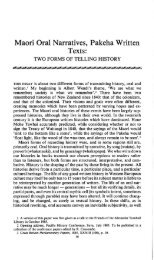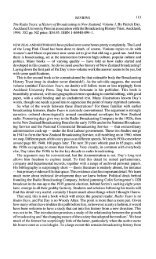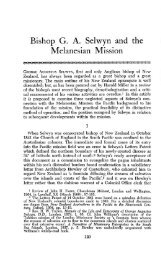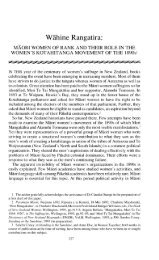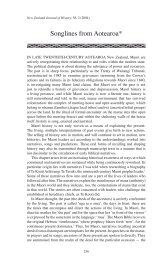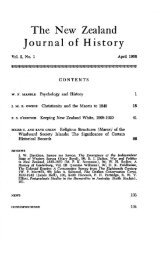Songlines from Aotearoa* - New Zealand Journal of History
Songlines from Aotearoa* - New Zealand Journal of History
Songlines from Aotearoa* - New Zealand Journal of History
Create successful ePaper yourself
Turn your PDF publications into a flip-book with our unique Google optimized e-Paper software.
SONGLINES FROM AOTEAROA 267<br />
holes, three holes. The pits were to bury them, alive. They stand there, and<br />
Rua told the policemen, “Well, if you are going to put me to death, I want you<br />
people to shoot me, once. One shot. If you don’t kill me with one shot, that is<br />
to let you people know that I am the Son <strong>of</strong> the living God.” So they shoot him<br />
all right . . . . Well, he lived <strong>from</strong> that day, <strong>from</strong> 1916, right up to 1937. And<br />
no medical treatment; he only had the Mäori way.’ 46 Maori myth-narratives<br />
<strong>of</strong>ten focus on the transference <strong>of</strong> power to the next generation. Thus, they<br />
follow the general pattern <strong>of</strong> narratives about a son who claims his paternal,<br />
or maternal, lineage and who completes the unfinished tasks, just as Tawhaki<br />
identified, and recovered, his father’s lost bones. As Hirini Mead commented<br />
in his introduction to his recent retelling <strong>of</strong> the Tawhaki cycle, ‘Nowadays we<br />
think that sons should complete the tasks not finished by their fathers during<br />
their lifetime.’ 47 Mead thereby indicated, in simple form, the quest-formulae<br />
that have continued to evolve, seeking to address modern Maori concerns.<br />
Other succession narratives are couched as continuing quests, undertaken by<br />
rival claimants who each sought to prove that they were Te Kooti’s predicted<br />
successor. Between 1921 and 1923, Wi Raepuku (Ohana) undertook a series <strong>of</strong><br />
tasks to establish his claim that he had opened the ‘seven seals’ that he said had<br />
been laid on the land by Te Kooti. Wi Raepuku began his long journey <strong>from</strong><br />
Whanganui to Te Wainui, the land given to Te Kooti’s followers in the eastern<br />
Bay <strong>of</strong> Plenty, on 1 July 1921. On this date (one <strong>of</strong> the pillars <strong>of</strong> the Ringatu<br />
year), at Otoko marae on the Mangawhero river, Wi announced himself to be<br />
the predicted child <strong>of</strong> Te Kooti (‘te tamaiti a Te Kooti’). 48 The little meetinghouse<br />
at Otoko, called Tauakira, had been renamed by Te Kooti in 1891 ‘te<br />
Parakuihi’, the Breakfast, indicating its importance in the turn <strong>of</strong> his fortunes in<br />
the Whanganui district. He then span a riddle for the house, which Wi Raepuku<br />
set out to fulfil:<br />
Otoko . . .<br />
1. Tenei whare koTauakira, me hua e ahau ko te Parakuihi, a ka tina ahau ki konei.<br />
Otoko . . .<br />
1. This house is named Tauakira, but I shall name it the Breakfast, and I shall have<br />
dinner (repletion) here. 49<br />
Wi Raepuku led a pilgrimage <strong>of</strong> believers <strong>from</strong> Otoko through all the places<br />
associated with Te Kooti. They likened themselves to the children <strong>of</strong> Israel,<br />
‘nga tamariki a Iharaira’, just as Rua’s followers had done. Their journey took<br />
them through Kauangaroa and Karioi, along the Desert Road by the great<br />
snow-capped mountain Tongariro, <strong>from</strong> where Toiroa traced his descent, and to<br />
Whakatane in the eastern Bay <strong>of</strong> Plenty. At every spot they rested they planted<br />
trees to mark the stages <strong>of</strong> their pilgrimage. On 1 January 1923 (the first pillar<br />
<strong>of</strong> the Ringatu year), at Te Poroporo marae, Whakatane, Wi Raepuku claimed<br />
to have opened the ‘fourth seal’, Te Umutaoroa, or ‘the hangi (earth-oven)<br />
<strong>of</strong> long cooking’. Then, on the following 1 July he made the first <strong>of</strong> several<br />
unsuccessful attempts to exhume the bones <strong>of</strong> Te Kooti in order to take them<br />
back to Poverty Bay, Te Kooti’s birthplace. In this quest, to find the hidden<br />
bones <strong>of</strong> Te Kooti, which Wi Raepuku called the ‘sixth seal’, he failed.



